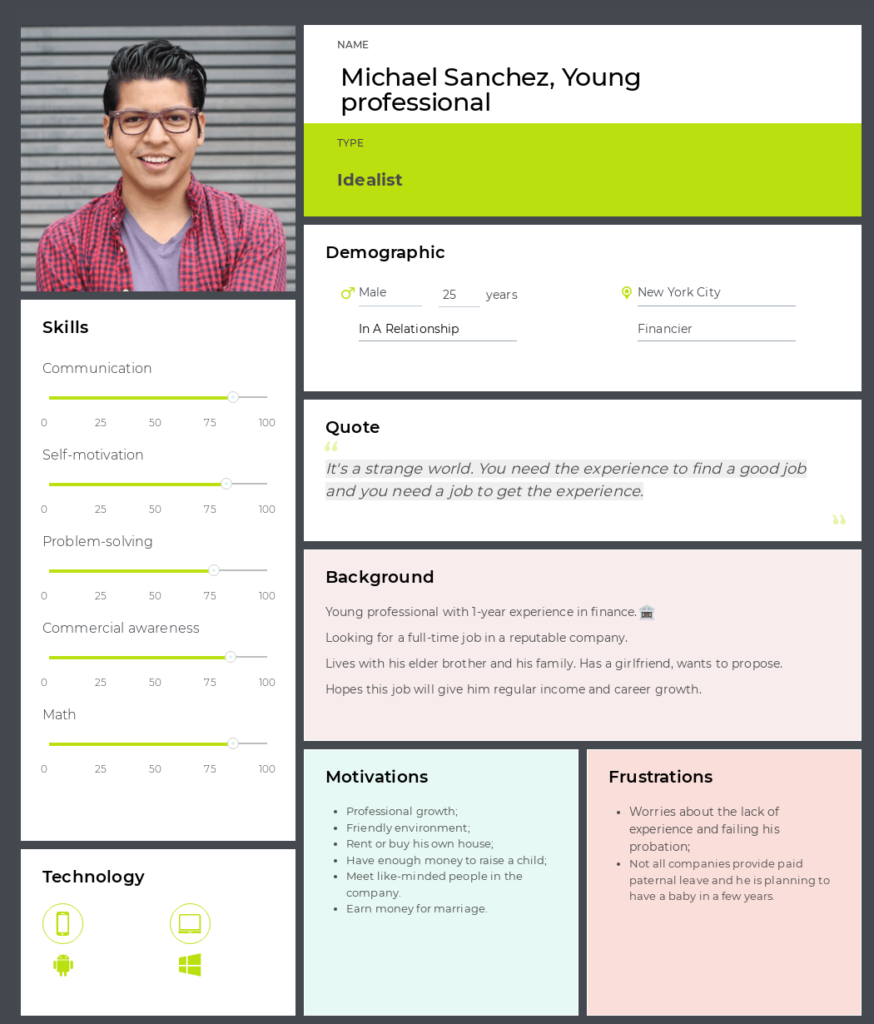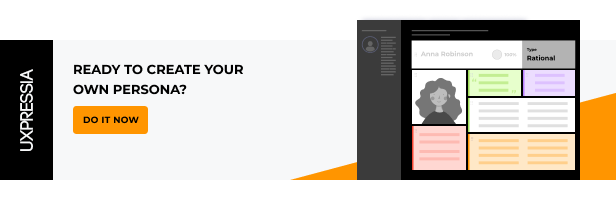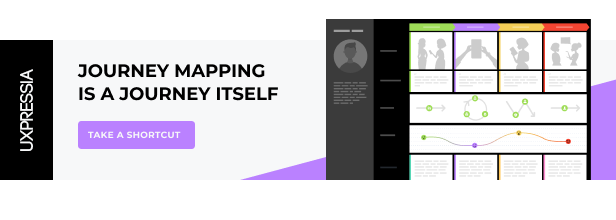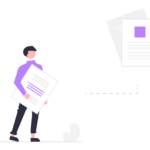Experience. Whose experience business strives to improve more often? Their customers. But what about employees? No CX will be great with poor EX. It’s simple like that. If you already got it and want to figure out an end-to-end employee journey in your company with mapping, keep reading, and we’ll show you how to do it in the most efficient way.
For the record, employee experience mapping is not much different from customer experience mapping. But there are nuances. You can read about those in our latest whitepaper, while in this article we are going to walk you through the employee persona’s creation and mapping of each stage of a fictional end-to-end employee journey. And we’ll do it using a detailed example with multiple steps, problems, and ways of experience’s improvement of an employee persona. Finally, at the end of the article, you will find a full-fledged and downloadable end-to-end employee journey map template to create your own map upon it.
Contents
Employee persona creation
It all starts with research. Collect complete, reliable, and varied data as a foundation for your personas. You can take the easy path and use the job role or the time spent in the company to divide your team into groups to form personas, but it doesn't guarantee that those will be really homogeneous in their journey with your organization. Imagine that one of the two top managers has been working in your company for several years and started their way as a trainee while the other is recently hired as a CFO. Similar job roles, different journeys. Think of using behavioral patterns instead of age and gender only for creating employee personas. Then spice up created profiles with more details (demographics included).
For this article, we created a persona of a young professional with no work experience who is willing to make a career in the financial sector. His name is Michael and he wants to separate from his family, marry his girlfriend, and have a child. Therefore, in addition to interesting job tasks, our persona is interested in material benefits. Michael also values communication and a friendly team since he’s nourished by strong social ties.
Let’s finally meet him.
As you see, we also wrote down Michael’s motivations, frustrations, the technology he’s used to, a few demographics, among other things. All to make him feel real and add an empathetic perspective. Be sure to do the same for your employee persona to sympathize with them when mapping and analyzing their journey.
Once you’ve done with the persona, the journey mapping comes into play.
Creating an end-to-end employee journey map
First of all, you have to scope. Like really. Mapping any end-to-end journey is quite challenging, but mapping an end-to-end employee journey may burn you out—there are lots of events during an employee’s life, even if they don’t spend a very long time in your company. Let alone people who’ve been working at the same place for decades. Just imagine what an event-rich journey they have.
Yet if your team is ready to take the challenge, let’s see how to map such a long journey on Michael’s example. We’ll follow his path from the decision to find the job to resignation and further actions. Technically, it’s not the end-to-end employee journey since we skip some stages like the awareness one, but aside from that, we’re going to nail it.
Ready?
Stage 1: Attraction
At this stage, your future employee starts looking for a job. And it’s a non-linear process. No matter when and how you and your future employee find each other (recruiting cold emails, online brochures, third-party hiring platforms, etc.), they may well have had interviews with other companies. Therefore, already at this very early substage, it’s essential to hook your future hiree with a good experience. If you involve a third-party HR, be sure they represent your company correctly as they form the first impression. When you do it yourself, try to choose the right channels for communication, and the same applies to timing. If you write to a person in an informal messenger on Saturday night, most likely, communication will not work out. When you offer remote jobs, make it clear in the ad.
And remember that once you catch the eye of a person you’d like to hire, they start to collect information about you as an employer. Does your website provide comprehensive data about the company? Is the description of your vacancy exhaustive? What do former and current employees say about you on the Internet and offline? How easy is it to reach out to you and ask for details?
- Awareness & First contact

We divided Michael’s Attraction stage into two parts as it's action-intensive. First, Michael is trying to look for jobs at different websites and asking friends for help. Until he gets the message via Linkedin from a recruiter hired by a famous company to find an aspiring financier. Michael’s pleasantly surprised since his profile is almost empty and is worried, too. How did the recruiter find him? Maybe it's a prank? The job title looks unfamiliar. And Michael doesn’t believe that such a well-known company could have chosen him and that he can pass the interview. Besides, the recruiter doesn’t give him enough information about the position and work conditions. So he continues to consider other options.
The first contact is a significant moment in your relationship with a soon-to-be hiree. When entrusting this task to another person, make sure that they have comprehensive information about your company and vacancy and fully disseminate it.
Also, think about your job description. Is everything clear about it? Try not to use internal terminology since a person from the outside will not understand whether they fit the position with unusual wording.
- Research
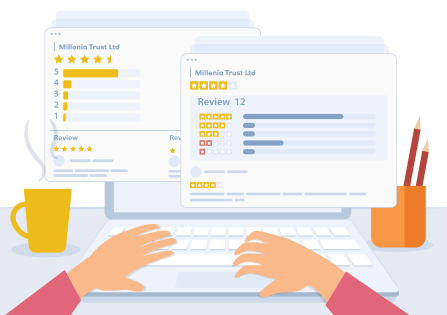
Michael takes things into his own hands and starts researching the company. Truth to be told, even if you tell the candidate your company’s entire history since its inception, they will scrutinize you. What do your competitors say about you? What is the impression of your social media? Or maybe an acquaintance of an acquaintance of a future employee works in your company and can share something? You might think that reputation is something that’s out of your reach, but in fact, it’s a reflection of your employees’ experience. One or two controversial opinions will not affect anything, but if disgruntled workers leave you en masse, rest assured, this will be reflected in the subsequent hiring process.
So Michael reads job review sites and looks for additional information about skills that the position supposes. After talking with the recruiter and personal research, he decides that he has nothing to lose and wants to meet the HR.
Stage 2: Recruitment
Okay, the candidate is in your metaphorical bag, and the next stage begins. During recruitment, you will meet them for one or a few interviews, give them a test task, make your choice, and let them make theirs.
To begin with, how are you going to meet a candidate: in person or via video call? If the latter, offer several options that work for the candidate and time slots to choose from. The point is not even to demonstrate flexibility, but that the first meeting is already a very anxious event, so the platform should definitely be familiar for both parties to reduce problems with communication. If you want to talk about something specific, send the applicant a list of topics or questions. It’s soothing to prepare and collect their thoughts in advance for people whose work doesn’t involve public speaking.
Interviewing is stressful too, but you can call on a colleague to support you while the candidate doesn’t have that luxury. A comfortable environment will be more than welcome. One of the possible problems can be a weak internet connection. If you both can’t fix it, renegotiate for another time so as not to spoil your conversation. When it comes to offline, prevent your candidate from getting lost on the way to your place by telling them in detail how to find the office. And meet them at the entrance if that’s possible.
Is it a match? Make the offer. But make sure your candidate knows how long the decision-making process takes. Otherwise, they may accept another offer before you will make yours.
- Invitation
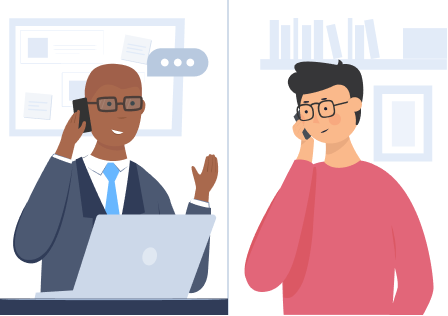
Michael gets the invitation for the interview that will take place in the office. He’s glad that he’ll immediately see his possible office. Before the meeting, Michael searches the company’s website and stumbles upon a vacancy he likes and the recruiter never mentioned. At the same time, he doesn’t see the vacancy they were talking about. Michael is confused. Can he mention his interest in another position during the interview? Why didn't the recruiter tell him about it? What if the recruiter messes up the vacancies and the interview will be devoted to another job position? Of course, most likely, the site was simply not updated on time. What about yours? Does the information on it mislead future employees?
- Interview

Michael quickly finds the office and is greeted by the HR and CFO. He’s confused again as the recruiter said that today the meeting would be with the former only. Michael is treated with coffee and the women are walking him to a cozy meeting room, yet his nervousness grows. In your case, be sure to inform a candidate and notify about the changes in advance.
After the interview, Michael leaves the office in a good mood, but he gets no feedback and his excitement soon gives way to anxiety. It’s clear that you need time for other interviews and to consider the candidate, but a couple of general phrases about how the meeting went will be great and indicate the time when you will give your answer.
- Offer

Michael has fallen into the trap of long waiting that no one had told him about in advance. He even starts looking in the direction of other vacancies when he finally gets a call from the HR. She tells him the company wants to hire him and asks to receive the offer on an online platform they use via the link from the email she’s going to send to Michael. It seems to be joyful, but ugh. In addition, the candidate doesn’t remember everything the HR said over the phone, and the follow-up email only contained a link to the offer. You have to keep in mind that everyone perceives information differently and it’s better to duplicate important details in your emails. In addition, the candidate may not be familiar with the platform you have chosen for making the offer, so attach instructions to it just in case.
Stage 3: Onboarding
We move on to the next stage of the end-to-end employee journey. Here, the new hiree goes through the paperwork, understands in practice what they have to do, proves to colleagues and top management that they can handle the position, and draws conclusions regarding the team and working conditions. This is a kind of honeymoon period, in which sometimes there’s not enough honey. Yet everything’s in your hands.
What happens to the new hiree before the first working day? This varies from company to company. Some prefer to do all paperwork before day X, while some include it in the onboarding process. Somewhere an internship for adaptation takes place, while somebody invites an employee on an office tour. Certain employers send a letter with useful links related to the job and the company or treat their newbies with branded sweets. Never done anything like this before? It might be worth a try.
What else should you pay attention to? The process of signing a contract. If it’s digitized, make sure the candidate knows how to use the specific software. Even better, add some fun to the process. Come up with a quiz so that in a playful way you can check if the hiree’s ready to join the team.
Once the work starts, the employee dives into the ocean of new information, people, and tasks. Provide a buddy to break the ice. Give them detailed instructions, tell who and with what questions they may contact. This will help the employee navigate in the beginning in the company and reduce stress. And once the probationary period is over, share the fullest feedback. Something went wrong and you want to stop working together after probation? Do it with empathy and explain your reasons. Is everything okay? Forget the routine phrases and better share your plans for further cooperation and ask what the employee would love to improve or change in the work process.
Let’s see how Michael goes through onboarding…
- Pre-boarding
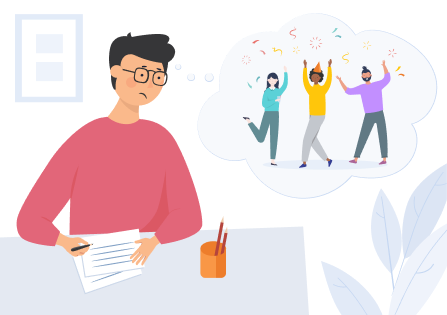
Too bad, even lovely things may not be in your favor. For example, Michael gets an invitation to the office to meet the team while the team has not been warned or relieved of duties. As a result, the meeting doesn’t go very well, and Michael sees that he’s not very welcome. It’s likely that people would react differently if they were not worried about the tasks they were distracted from. Think over such initiatives, taking into account not only the new employee’s interests but also those of the rest of the team.
- Induction

Michael is doing well, but he worries that no one gives him feedback. Does he manage? Do colleagues enjoy interacting with him? It may seem obvious, like, no one scolds, so everything’s fine. But it's vital to remember that without feedback, an employee can feel lost and lose motivation. Michael also finds it difficult to navigate the office, which is huge. He is supposed to contact the HR for all questions, but she's always busy and it’s difficult to find her on the spot. This could have been avoided by distributing onboarding questions among the entire team. It will help the hiree get to know everyone in the process and won’t distract the rest of the team from their work too much.
- End of probation

Michael works hard. He thinks he’s lucky with the job and wants to establish himself and get a promotion. He’s always ready to help colleagues, stay after work and even do something on a day off. However, in the bustle of the work, no one pays attention to this. And it’s a dangerous moment since the employee can burn out at the beginning of their journey with you. Overworking your staff brings mutual losses for both them and the company. If working extra hours necessary, be sure to pay for additional hours or taxis if the employee returns home late. It will sweeten their experience and prove you to be a fair employer.
Stage 4: Development
We’ve come to the longest stage of the end-to-end employee journey, Development. As part of it, the employee develops skills, gains new knowledge, improves as a professional, grows up the career ladder, etc.
First, you need to set the right direction for the employee journey. For example, not all employees strive for vertical skill development and more responsibilities, some would love to raise their competence level, perform more complex tasks and become the best within their niche. You have to note what’s more appealing for the worker and help them along the way. For instance, not everyone has the courage to ask their boos to pay for a course or an industry-related conference. Make the first move when you see that the employee’s ready.
Sometimes top managers quit, retire, or the company grows and new positions open. If you exclusively hire outside executives, your employees find themselves hitting a ceiling that they can't break, which diminishes motivation. So if you have a fitting candidate from the current employees, don’t hesitate to promote and support them after that (e.g., help with the relocation or new skill development).
There are more that can take place during this stage of the journey—parental leave, office events, wage increase negotiations, business trips, and so on. Michael’s example will shed some light on some.
- Development & career planning
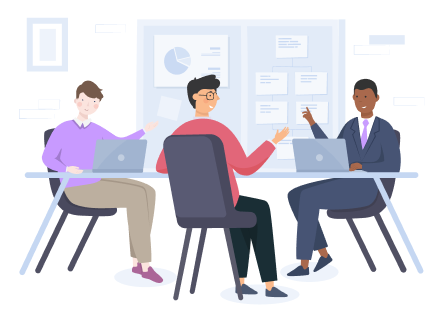
Michael volunteers to help his boss in almost every project. This way, he distinguishes himself from others and tests the boundaries of his skills, identifying gaps and points for growth. But he makes mistakes every now and then because there are many things he has never done before. If you see that some employees take the initiative, want to grow, and positively affect your business, help them. Pay for their studies, if possible. Offer to buy the tickets for a job-related conference they’d love to attend. Entrust interesting projects. All this will have a positive impact on their experience and motivation.
- Skill upgrading
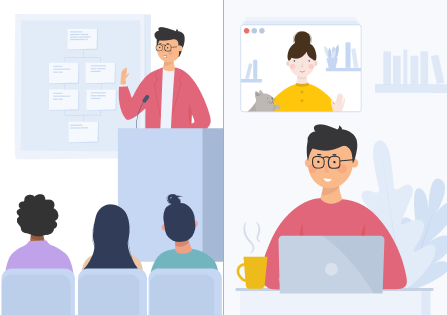
Michael is eager to improve his skills. He goes to the HR, but she’s not aware of how the company can help him. Yet the HR is ready to collect the information for him, which is already good. You can always anticipate such a thing. For example, send emails to employees with training options, exciting industry hybrid events, and various workshops. Motivated employees will seize the opportunity.
- Annual performance evaluation

Michael understands that some evaluation of him as an employee takes place only once a year and that’s too rare to get the promotion sooner. Think about the ways to give your employees feedback on an ongoing basis. Send emails upon completion of projects, highlight employees’ achievements at meetings, make little everyday notions, and such. Since an employee who knows how useful they are and what professional advantages they have will be much more effective than those who just go with the flow.
- Promotion

Michael gets the promotion, but his joy quickly gives way to fatigue. He can’t expand the team while the pile of tasks can beat the Eiffel Tower. Employers often miss this point. When somebody gets a promotion, their previous job and tasks don’t dissolve in thin air. Are you sure your teams have enough members to work efficiently? Notice that when an employee ups the career ladder, it’s like yet another onboarding for them and they need as much support as at the beginning of their work with you.
- Office event

Michael works so hard that he doesn't communicate informally with his colleagues. One day he comes to an office party and realizes that he’s all alone in the crowd. After propping up the wall, Michael goes home. In fact, this is terrible. If a person doesn't fit into the team, there’s a high probability that you will lose them for good. You can't force people to be friends, but you can create situations where communication and networking flourish. Well-coordinated teams work more efficiently since people in good relations find it simpler to turn to each other for help, discuss issues and come to compromises.
- Paternity leave
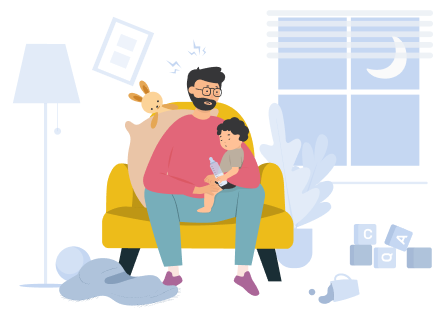
Michael takes paternal leave and falls out of the life of the company. He sometimes communicates with a few colleagues, but very superficially. During this time, he loses contact with the organization and even thinks he should quit since he spends too much time at work yet has no friends there. If such an employee has the opportunity to sometimes participate in the company’s life, invite them to your events, ask how they are doing in an informal chat, make them feel that they are still part of the team and are expected to come back. Consider sending them weekly letters with major events in the organization to stay informed and don’t feel overboard. This also will make it easier for them to get back to work.
Stage 5: Retention
In fact, this stage has no strict boundaries, it lasts in parallel with other stages throughout the entire end-to-end employee journey and concerns the employee's interest in work. Money alone can’t stipulate motivation, so businesses need to look for alternative solutions and individual approaches. Some workers crave challenges, while others want comfort and a friendly environment to do their job with joy.
And there will always be a moment of doubts and the desire to change their job. Some employees will overcome this crisis, others will quit the company. The problem is that this moment is difficult to foresee. In order not to miss it, maintain a good relationship with your team and not only give them your feedback but collect their feedback too. And do it regularly. Did you notice a decrease in satisfaction? Take action.
- Doubts

After the paternity leave, Michael is in disarray, as he has been able to look from the outside at his career and get horrified at how much time and energy he gives to work, where he’s not heard and no one’s eager to help him. The team doesn’t grow, in contrast to the number of tasks that become routine. Michael receives a good wage, but every day he’s less and less happy about it. Do you see that the employee has slowed down or stays up late? This won’t affect your business and not in a good way since the performance level of such a worker drops. Talk to them confidentially and try to solve their problems. It’s always easier and cheaper for you to prevent your employee’s burnout than squeezing all the juices out of them and looking for a replacement.
Stage 6: Exit
Employees quit, it happens. And this is not a bad thing, teams need fresh blood, and old employees need new horizons. But why do they leave your company? This is an interesting question, and no one will answer it better than the employees themselves. Reach out to those who have already left, speak with those who have decided to do the same. Their feedback may be the most sincere you can have.
And here it's important to note the interconnection of all stages of the end-to-end employee journey. Not only take into account the information received from those who leave your company but also turn it into an action plan and initiatives that will improve the experience of current employees and prevent their premature resignation.
- Offboarding

Michael spends his last days in the company in the hustle and bustle because of paperwork. As a result, he has no time to say goodbye to his colleagues properly. All because he has to figure out how the letter of resignation should look like, what he must do before leaving, and other essential things.
To smooth the goodbye experience, you may throw your colleague a little party or organize a collective farewell so that the leaving person doesn’t go away in silence.
- Feedback
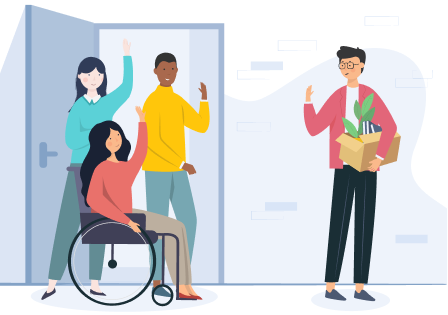
Nobody asks Michael what caused his resignation, but he has something to tell. Former workers’ experience is a great help in enhancing the experience of your current employees. Even if an employee leaves you with a smile on their face and is eager to conquer new peaks, learn more about their experience throughout the journey with your company. Be prepared for possible unpleasant details, as well as to fix those in the future.
Stage 7: Advocacy
After employees leave the company, they continue to be associated with it. They will be asked what it’s like to work for you, what is the atmosphere in the team is, why they left after all. They write reviews on specialized portals and shape the image of your organization.
If you didn't get insights when an employee left the company, this is your second chance. Сheck job reviews portals to collect valuable opinions. In addition to gathering information, you can politely start conversations on open resources with previous workers: ask clarifying questions and report on the changes made based on their feedback. For the former employee, this may no longer mean anything, but for current and potential employees who may stumble upon these messages, your position will look mature and empathetic.
- Opinion sharing

Michael writes a post on a job review portal since no one contacts him personally, and he hopes that at least this way his former company will notice his opinion and learn about his experience. He also shares his thoughts with acquaintances when they ask him personally about his past job. What does he say? Is your business a great place to grow as a specialist? Or maybe a grinder that has no mercy for its staff? To know for sure, don’t hesitate to contact your former employees after a while. Their feedback will be more honest than the feedback of current employees, and that means a lot when it comes to employee experience improvement.
The template
So, we listed the possible stages of your end-to-end employee journey, but feel free to tweak those, cutting some off and adding more relevant ones when you will map your own case. Our end-to-end employee journey map looks like this:
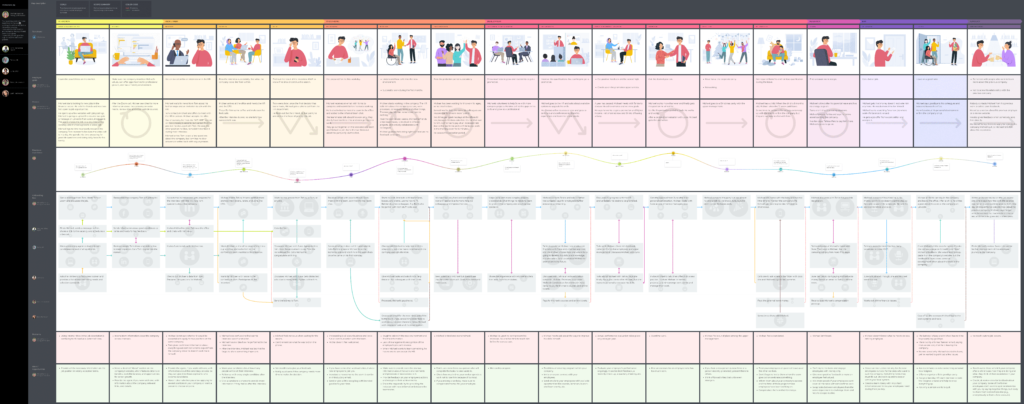
Above, we outlined what Michael went through, who he interacted with, and what challenges he faced. The map itself has more details, possible problems that many employees encounter on their paths with different companies, ideas on how to improve their experience. You’ll see the internal processes inside the company, channels the persona uses, their emotions, and thoughts. Everything’s visual and ready for further brainstorming, ideation sessions, and updates.
This template and the employee persona’s profile are free to download and apply to your mapping initiative.
To sum it up
As you can see, the end-to-end employee journey can be simply huge, and each of its stages is wrapped in many vital nuances and points worth underscoring. We hope that such a detailed example of the journey will help you highlight the necessary stages in your particular case and make the life of your employees comfortable, efficient, and positive. And happy employees will undoubtedly bring success to your company.
